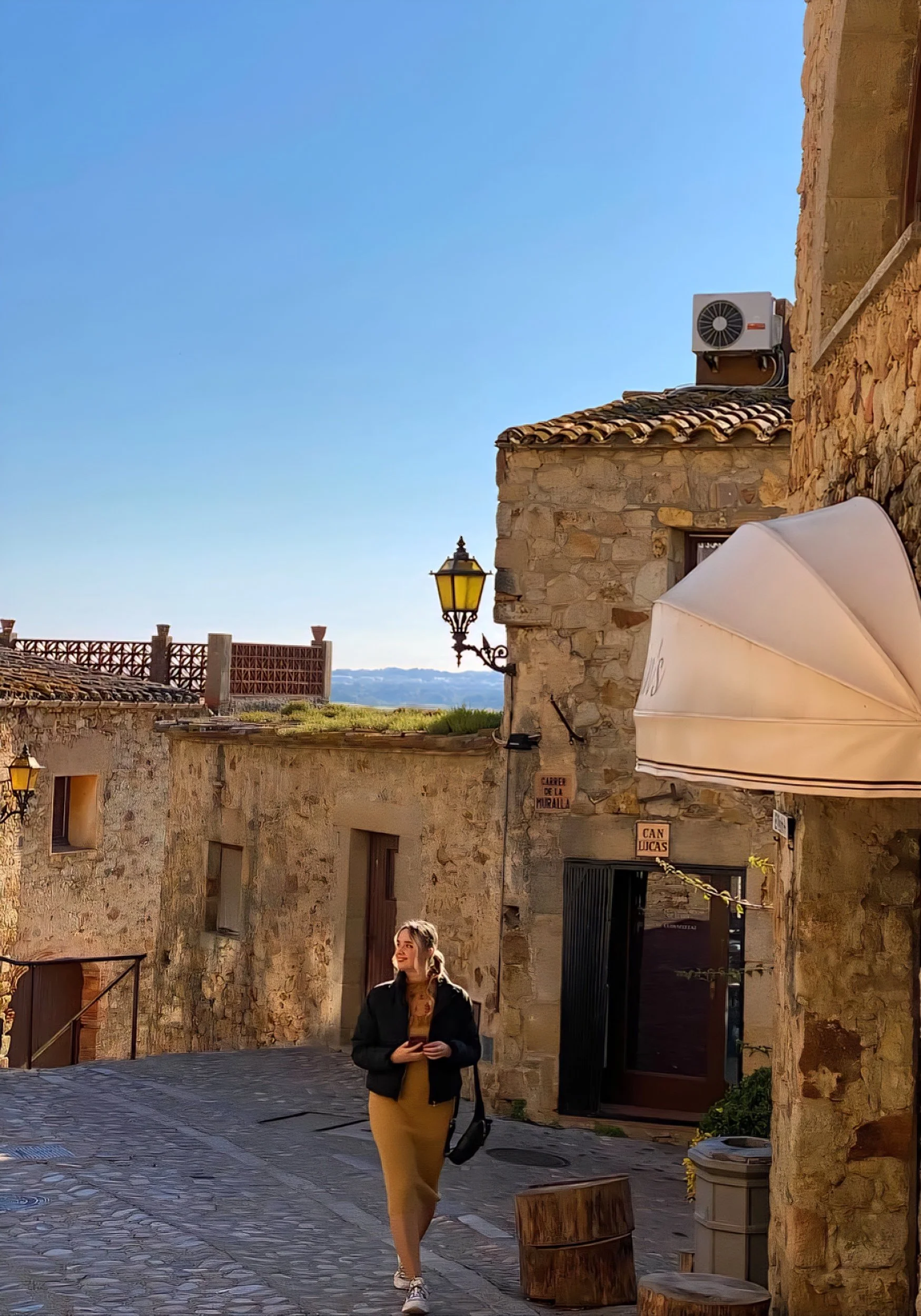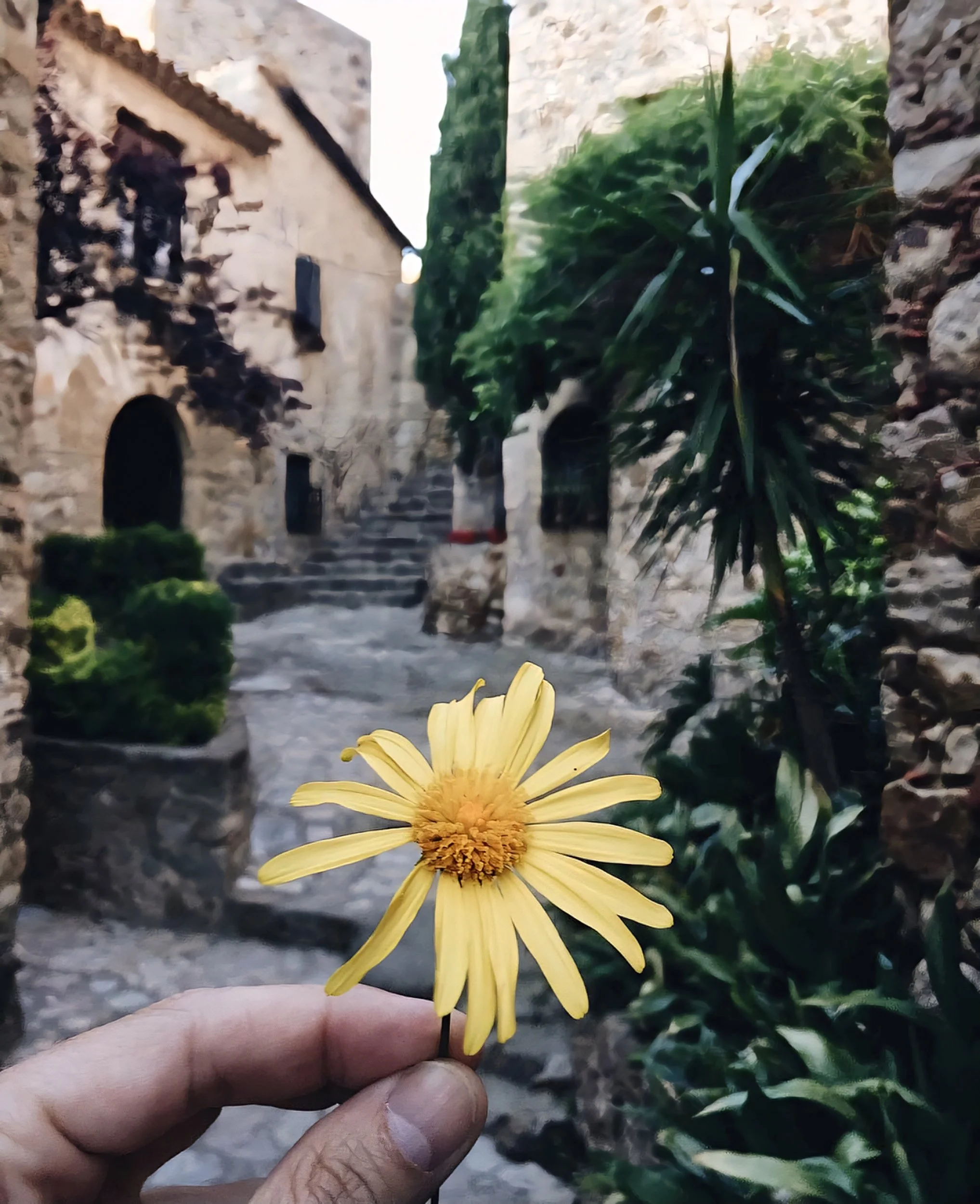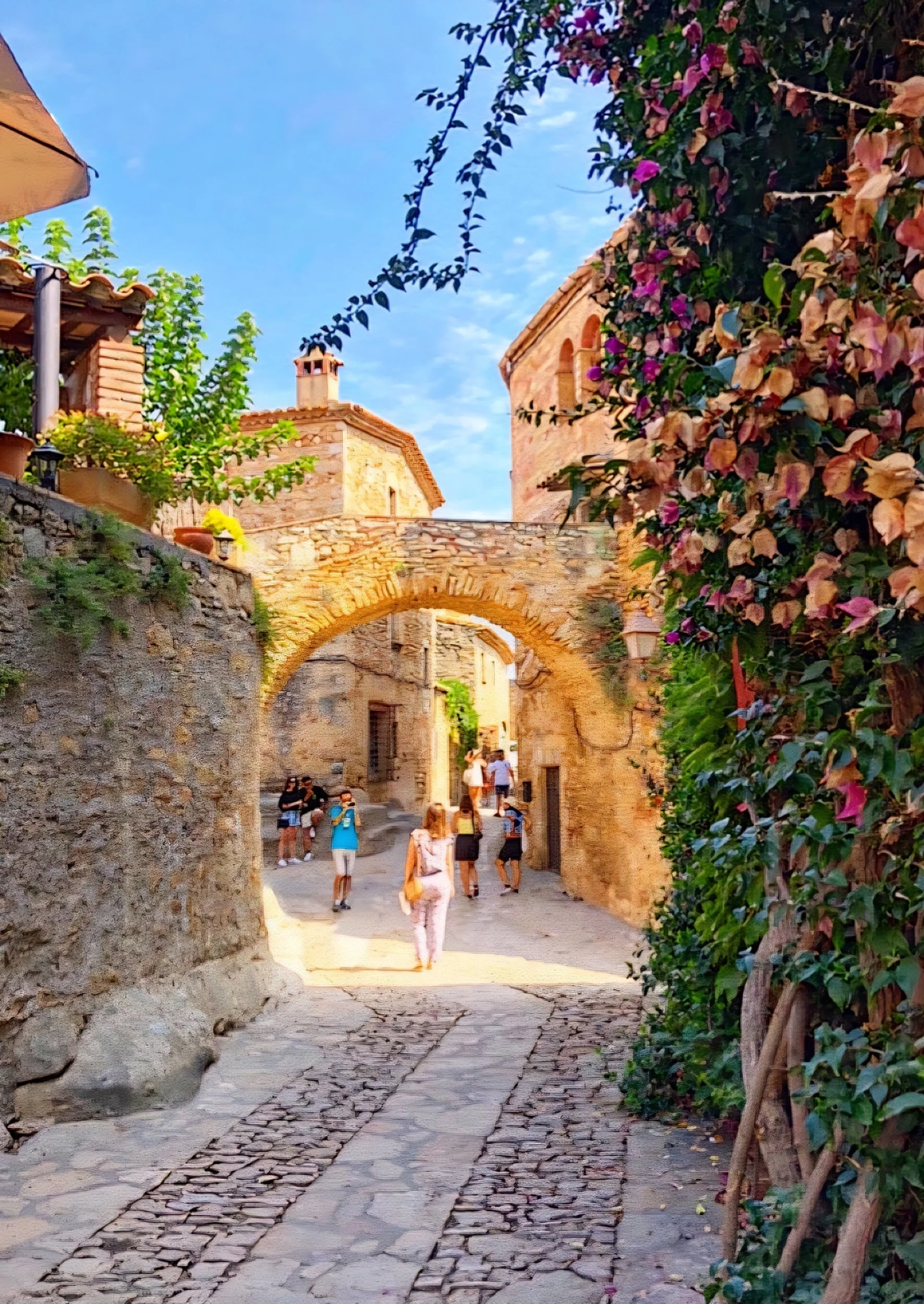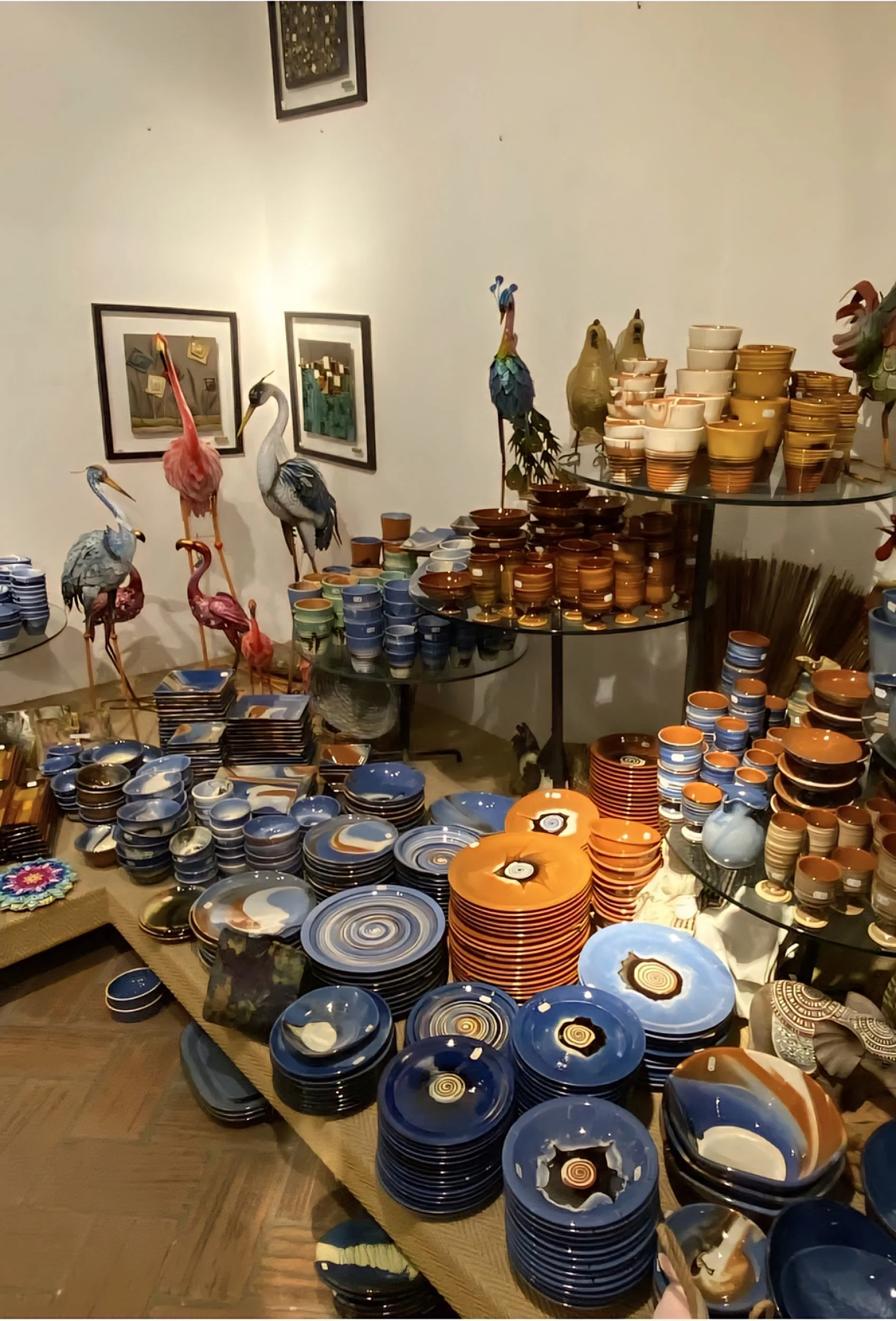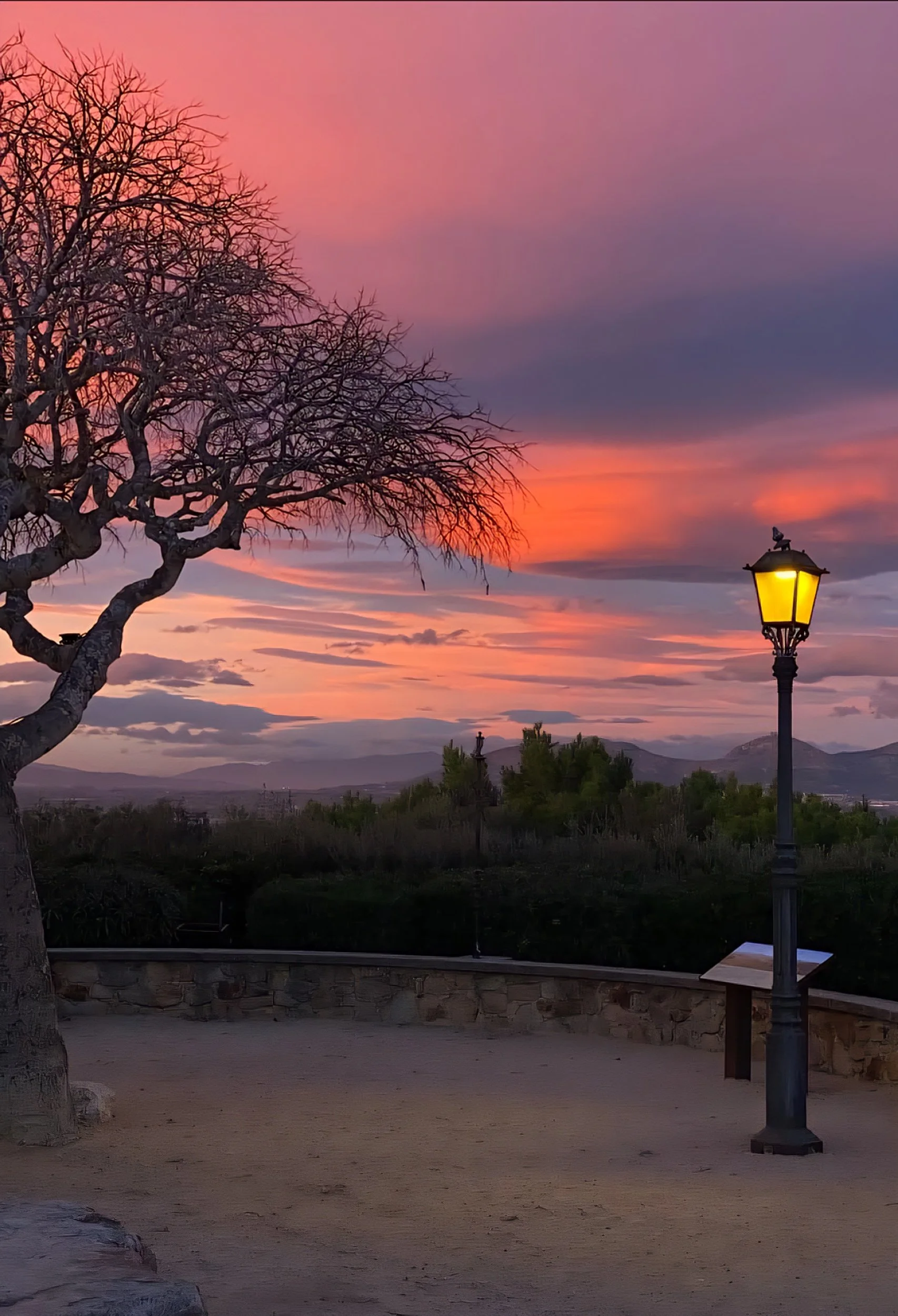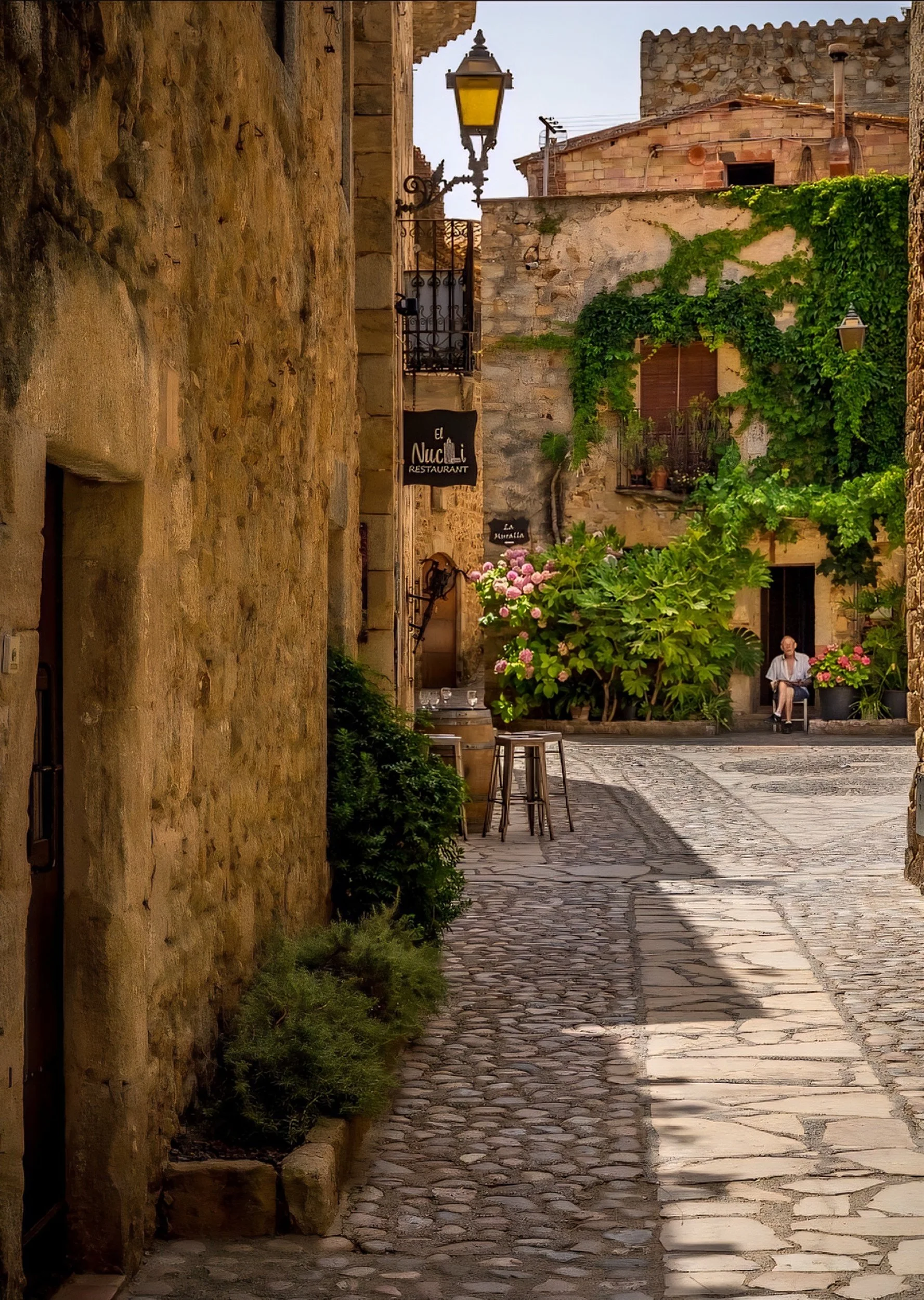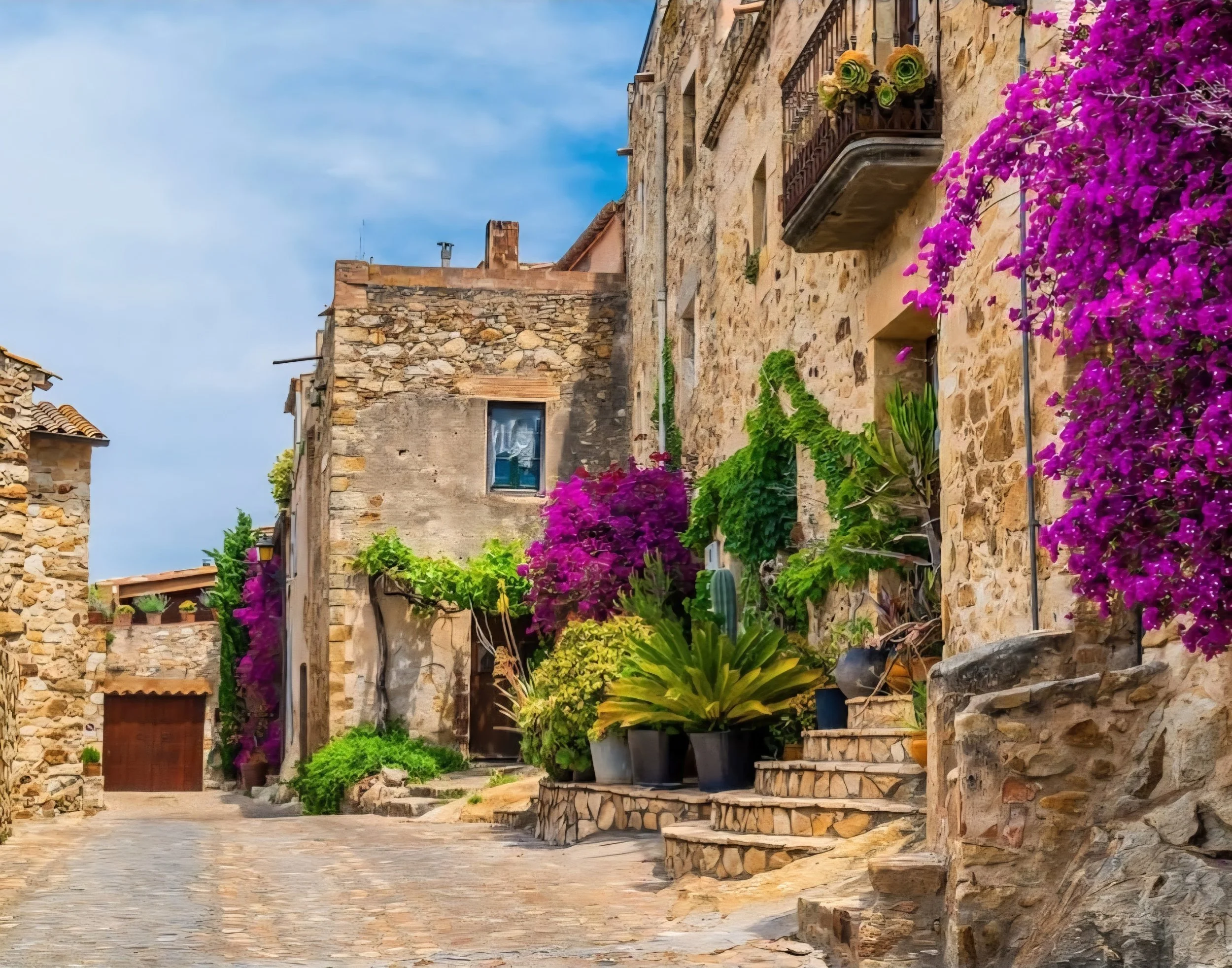A Quiet Weekend in Pals: Slowing Down on the Costa Brava
You know those places you didn’t plan to fall for? But a few hours in, you’re already figuring out how to stay longer? That’s what Pals was like for me.
It’s a small medieval town just a bit inland from the Costa Brava, and honestly, it doesn’t look like much on a map. But in person? It’s calm in a way that’s hard to find these days. You park just outside the old centre, walk up the slope, and suddenly you’re surrounded by stone buildings, curved alleyways, and warm terracotta rooftops that feel like they’ve been there forever… because they basically have!
A stoll through medieval part of pals in spain
Most people come here as a quick detour on their way to the beach. And sure, you could do that. But if you’re the kind of person who likes slow mornings, small places, and not having a packed itinerary with things you must see and do, Pals deserves a full weekend. There’s enough to see, but not so much that you feel like you’re missing out if you spend half the day sitting with a glass of wine in the shade.
It’s so quiet you actually hear yourself walking. No one’s rushing through dinner, and honestly… once you’re here, you’ll probably end up thinking, “Yeah, one night’s not going to be enough”.
It’s also a good base for exploring this quieter corner of Catalonia - especially if you’re planning a road trip through Baix Empordà or just want a break from busier coastal spots. And if you prefer peaceful mornings, long walks, and small towns with good food, you’ll probably feel right at home here.
Let’s take a look around.
Why Visit Pals
Pals doesn’t make a big deal out of itself, and that’s kind of the whole charm. It’s up on a small hill, a bit inland from the Costa Brava, and when you get to the top, you’ve got views out over fields, rice paddies, and hills in the distance. You can see the sea one way, and the Montgrí range the other. It’s beautiful! Just really solid, peaceful scenery.
The heart of Pals is its medieval quarter, which has been carefully preserved but not overly modernised. You’ll find Gothic archways, stone towers, narrow staircases, and houses with weathered doors that have clearly seen a few lifetimes. It’s easy to explore in under an hour, but the point isn’t to check it off - it’s to wander around and stroll without a map.
Pals has also been known for centuries for its rice (Arròs de Pals) grown in the fields just beyond town. That connection to the land gives the place a slower pace and chill vibes. You’re just as likely to see someone heading into the bakery as you are a farmer driving through town with a truck full of produce.
It’s definitely not a resort town. It’s a living place - and one that welcomes travellers who appreciate local Spain.
Things to Do in Pals (When You Want Culture, Calm, and a Bit of Curiosity)
You don’t come to Pals with a long “bucket list”. You probably come because you want a change of pace: to walk without noise, to find the kind of shops where someone still writes prices by hand, and to eat lunch somewhere where the chef isn’t trying to go viral, right? It’s a small town, yes, but if you give it your full attention, there’s more than enough to fill a thoughtful weekend.
Here’s how to do it, your way:
Let yourself wander the medieval centre more than once
Pals isn’t big, but the layout is just crooked enough that you’ll turn the same corner twice and still notice something new. A carved doorway, a painted tile, a cat sleeping in a windowsill you missed the first time. It’s such a pretty town to explore.
You’ll probably start in the main square, Plaça Major (everyone does). From there, just make your way up toward the Torre de les Hores, the old bell tower that sort of keeps an eye on everything. But don’t rush it. Sit on a bench for a bit. Watch people go by. Look up at the balconies. This isn’t one of those places where you need to “see it all.” Just take your time and wander! The slow way down is usually the better one.
Visit a local ceramic studio, gallery or artisan shop
Pals is surrounded by a region full of artists, and a few of them quietly sell their work in town - mostly in small workshops or shared spaces tucked between houses. Look for open doors or small wooden signs pointing upstairs. There’s often a mix of functional and decorative pieces: hand-thrown mugs, hand-dyed scarves, prints of the surrounding landscape. And the best part? You usually get to speak to the person who made it.
What you won’t find: anything mass-produced, overly packaged, or made for tourists. This is real local craft, and the makers are often happy to chat if you’re curious.
Support the tiny bookshop (you’ll know it when you see it)
There’s a tiny independent bookshop just off the main square you need to visit! There's no sign outside, just a wooden door and a quiet entrance. Inside, shelves lean slightly, and most of the books are in Catalan or Spanish, but the owner is happy to help you find a local poetry collection or a beautifully printed cookbook to take home. If you’re someone who collects beautiful editions, cookbooks, or just wants to browse somewhere quiet, it’s worth a stop. There are also local guides, small-run photo books, and kids’ books with stunning illustrations. It’s the kind of place you end up staying in longer than expected, even if you don’t buy anything.
Walk through the rice fields - or cycle if you want to go further
Arròs de Pals isn’t just a label.It’s actually the town’s agricultural backbone. If you’re into food culture or sustainable farming, visit the Molí de Pals, a working rice mill just outside town that still uses traditional methods. You can walk or bike from the centre (about 20–30 minutes), and the surrounding fields are beautiful, especially at golden hour.
Want to keep walking? Small trails lead off into the surrounding Empordà countryside where you’ll pass olive groves, vineyards, and the occasional stone farmhouse. Some paths even connect to nearby villages like Peratallada and Palau-sator, both great half-day trips if you want more of this quiet, rural feel.
Sit outside with a glass of vermouth… or three
Just off Carrer Major, there’s a spot with a few tables outside and vines growing up the wall! It kind of looks like someone’s patio, not a business. But if you sit down, someone will bring you a menu: local vermouth, olives, anchovies, maybe a house-made coca (flatbread). No branded umbrellas. No laminated signs. Just a small, relaxed place to sit for an hour and let the day stretch out.
Catch sunset from the edge of the town wall
There’s not really a big “viewpoint” in Pals. It’s more just little spots where the rooftops drop away and you suddenly get a view over the rice fields. If you head toward the back of the town around sunset, you’ll probably come across one. There’s a low wall, a bit of breeze, usually no one else around. No one’s lining up for a photo. It’s just quiet, and the light starts to shift, and you kind of forget what time it is!
What to Eat in Pals: Local Bars, Cozy Cafés & Restaurants
If you’re someone who prefers a handwritten menu to a neon sign, cold wine over crowded pubs, and small plates that tell you where they came from - then Pals will feel like just the kind of place. Here are three spots I found that match the mood and the quality we look for.
Antic Casino
This one is stunning. Set in a 19th‑century building near the old town’s heart, Antic Casino feels like a place the locals know but visitors appreciate. The focus is on fresh, regional ingredients: rice from the surrounding fields (you know about Arròs de Pals by now), seasonal vegetables, local wines. This is one of our favourite lunch spots in all of Catalonia!
Visit for lunch if you can: early dinner table, menu del día (set lunch) often gives you a chance to eat well for less. The terrace is shaded in summer; in shoulder season it’s just quiet and comfortable.
Es Portal
If you’re up for something a little more refined but still authentic, Es Portal is tucked just outside the main lanes of Pals. It occupies a restored farmhouse from the 16th century with solid rustic charm: stone walls, wooden beams, and a winter hearth (if you go in the cooler months).
The menu leans Catalan‑seasonal: dishes built around what’s local and available right now rather than shortcuts. It’s ideal for a slower evening - arrive early or reserve for after your stroll through the village when you’re ready to unwind.
Things to note about restaurants in Pals
Many restaurants in Pals source local produce, so menus may change day to day depending on what’s fresh. That means small surprises - not a huge buffet of recycled dishes.
Portions tend to be more relaxed rather than huge tourist‑plates. If you’re very hungry, consider sharing starters and mains.
In the quiet evening hours, especially outside peak summer months, some places close earlier… so check opening hours if you’re planning dinner after exploring late.
If your slow‑travel style includes minimal waste or local sourcing, ask about the rice: Arròs de Pals is a local product with a guaranteed‑origin label.
Lets talk about the Architecture in Pals
Pals is one of those places where the streets feel old. It actually reflects the centuries they’ve seen and it just adds so much character to the city. It’s a small medieval town, yes, but what makes it different is how intact and quietly layered everything is.
The town sits on a low hill overlooking flat, open countryside and the rice fields it’s historically known for. From the top, you can see out towards the sea in one direction, and the Montgrí Massif in the other - and that position wasn’t random. It was defensive, practical. Like much of the architecture here, it was built with intention, not just aesthetics.
The Torre de les Hores (you’ll spot it pretty quickly: it’s the old 12th-century watchtower) is one of the standout features, and it’s worth walking up to just for the view. Nearby, the church of Sant Pere is another good example of how Pals evolved. It has Romanesque bones, a Gothic layout, and a slightly odd Baroque touch that somehow works.
Wandering through the old part of town, you’ll see a mix of archways, vaulted stone ceilings, and doorways with faded inscriptions or carved initials. If you’re into small architectural details, this is the kind of place where it pays to look up and down! Lintels, window frames, ironwork. You’ll see it’s all been lived with, not recreated.
One thing I always notice in places like this: how the buildings match the land. The yellowish stone you see everywhere was sourced locally. Love that! It’s the same tone as the dust on the roads, the same colour the rice fields turn when they dry. That visual consistency makes everything feel grounded - and honestly, more calming to be in.
If you have time, stop by Ca la Pruna, a fortified 16th-century house turned small cultural centre. They sometimes have local exhibits or events, but even if it’s closed, it’s worth walking past to see how the older houses were structured. Thick stone walls, small windows, solid wooden doors. It gives you a good sense of how the people here used to live - and in many ways, still do.
A little tip: walk through the medieval lanes at two different times of day if you can. In the morning, the light is softer and cooler, and it hits the stone in a totally different way than in the late afternoon, when everything turns golden. It sounds small, but it completely changes how the place feels!
Where to Stay in Pals for a Quiet, Comfortable Weekend
There aren’t loads of hotels in Pals. What you’ll find instead are small, family-run guesthouses, boutique stays, and quiet countryside retreats that make you feel more like a guest than a booking. If you pick right, you’ll start to settle in by your second coffee.
Here are a few options that feel especially right for slow travel, solo trips, or a quiet weekend for two:
Hostal Barris
This is a no-fuss, family-run guesthouse right in the centre of Pals. It's comfortable, well-kept, and walkable to everything in the medieval part of town. Rooms are simple but clean, with tile floors and the kind of functional charm that just works when all you need is a good night’s sleep and a peaceful base. Bonus: they have on-site parking, which is a real plus in this area.
If you're planning on spending most of your time out wandering, reading, or enjoying long meals, this is a solid pick. Ask for a quieter room toward the back if you're sensitive to noise.
Mas Ferran (Adults Only)
A little outside the centre (maybe a 10–15 minute walk) this one is ideal if you’re looking for something peaceful. The vibe here is more grown-up and reflective. It’s the kind of place you check into with a book, a soft scarf, and zero intention of rushing anywhere. Rooms are bigger, and many look out onto the garden.
If you’re someone who needs space to breathe, or you’re travelling solo and want that in-between feeling of privacy and care, this one’s worth looking into. It would suit writers, couples who want to disconnect, or anyone needing a bit of exhale.
Arkhé Hotel Boutique
If you want something with a little more design detail (maybe you care about aesthetics, lighting, breakfast served on handmade ceramics) this is your place. Arkhé is still small and personal, but a bit more curated. The rooms feel thoughtful, and the overall atmosphere is calm and beautifully put-together.
It’s close to the old town but tucked just enough away that you can escape the foot traffic, especially in summer. If you value quiet mornings and good coffee, this one should be on your radar.
A Few Booking Tips
Stay at least two nights. Pals is small, but it opens up slowly. One night and you’ll feel like you’re just arriving. Two or three gives you time to settle.
If you’re driving, double-check where parking is. Some places have it on-site, others are a short walk away - and in the medieval part, the roads aren’t car-friendly.
Don’t overdo the stars. In a place like Pals, you’re better off going for character over rating. The best stays here are warm, personal, and quiet… not necessarily “luxury.”
How to Get to Pals
By train
The closest major station is Girona, which is well connected by train from Barcelona and Figueres. From Girona, you’ll need to take a regional bus or rent a car to reach Pals — it’s about a 45–50 minute drive.
By car
Driving is the easiest way to get here, especially if you’re planning to explore the surrounding area. From Barcelona, it’s about 90 minutes by car. Roads are in good condition, and the final stretch through the Empordà countryside is scenic and calm.
Parking
The old town is pedestrian-only, but there are several small parking lots just outside the centre. Park there and walk in - it’s a short, pleasant stroll and a nice transition into the town’s slower pace.
Where to Go Next: Daytrips Near Pals
If you’ve got a few extra days, or just want to make the most of your time in this part of Catalonia, there are a handful of nearby places that pair really well with Pals. All are close enough for a relaxed half-day trip, and each one brings something slightly different: from coastlines to tiny hilltop villages.
Peratallada
This one’s about 10 minutes by car, and probably one of the most charming medieval villages in the region. It’s even smaller than Pals, with narrow lanes and stone buildings that haven’t changed much in centuries. There’s not a ton “to do” - which is the whole point. Walk, wander, maybe grab a vermouth in the main square. Done.
Begur
If you want to mix your trip with a coastal vibe without hitting a resort town, Begur is a good choice. It’s around 15 minutes from Pals and has a more bohemian feel with small boutiques, modern cafés, and a few tucked-away coves nearby if the weather’s nice. The walk up to the old castle ruins is worth it for the sea views.
Palau-Sator
Super tiny, very local, and ideal if you want to feel like you’ve found a place no one else bothered to look up. It’s close to Pals and perfect for a short visit - especially if you’re into photography or just want a peaceful place to sit with a coffee and do nothing at all.
Gola del Ter / Platja de Pals
Just a short drive from town, the rice fields eventually give way to open dunes and long stretches of quiet coastline. In the off-season, it’s almost empty. If you’re up for a nice walk or want to see where the Ter River meets the sea, this is a great low-effort afternoon. Bring snacks and take your time.
Cyclist or slow-hike friendly areas
If you’re travelling with a bike or don’t mind walking a bit, the whole Baix Empordà region is laced with country paths and small back roads connecting villages and fields. There’s a cycling route that loops through Pals, Peratallada, and Ullastret. It’s mostly flat, with great views the whole way.
Before You Go
Pals may not be a headliner in most guidebooks, but that’s part of the reason it works so well - especially for travellers who aren’t interested in rubbing shoulders with other travelers.
You just need a couple of days, a good pair of walking shoes, and a mindset that leaves space for the little moments: a seat on a quiet terrace, a walk through the rice fields just outside town, a simple lunch that reminds you how good local food can be.
It’s also easy to fit into a broader Costa Brava or Girona region itinerary. Whether you’re road-tripping, using public transport, or mixing beach days with village stays, Pals makes for a perfect pause. It works well as a weekend destination, but also as a stop between bigger-name places like Girona, Begur, or Peratallada (especially if you’re craving something that feels less commercial!)
For solo travellers, it’s friendly without being intrusive. For couples, it’s peaceful and walkable. For anyone trying to take a breather from over-scheduled travel days, it’s a town that lets you do less -and feel good about it.
And really, that’s what slow travel is about. We love sharing those places with you here on Trippers Terminal!
More Slow Places You Might Love
If this guide to Pals hit the right notes for you (small town feel, good cafés, walkable streets, and space to breathe) here are a few other places worth checking out:
Santillana del Mar in Northern Spain – A tiny medieval town that’s surprisingly peaceful, even in summer. Think stone houses, sleepy squares, and long, quiet lunches.
Cozy cafés and art in Basel – If you like slow cities with creative energy and great coffee, Basel’s a solid pick.
Hidden cafés and unique stays in Windsor – Yes, there’s the castle, but also a quieter side with bookshops, local art, and small hotels that don’t feel like hotels.
Peaceful towns in Denmark – For soft mornings, empty trails, and places where it actually feels okay to do nothing.
Solo train weekends in Italy – Easy, calm getaways you can take alone - perfect if you need a reset and some pasta.
FAQs About Visiting Pals
Where is Pals, exactly?
Pals is in northeastern Spain, in the region of Catalonia. It’s part of the Baix Empordà area, just a few kilometres inland from the Costa Brava. You can get there in about 45 minutes by car from Girona, or around 1 hour 45 minutes from Barcelona. It’s also an easy detour if you’re visiting Begur, Peratallada, or other small towns nearby.
Is Pals worth visiting?
Yes - especially if you prefer quiet, atmospheric places over touristy hotspots. The medieval town centre is small but incredibly well preserved, and the surrounding area is perfect for scenic drives, bike rides, or short countryside walks. It’s ideal for a weekend getaway or a peaceful base while exploring the Costa Brava.
Can you visit Pals without a car?
Technically, yes… but having a car gives you much more freedom. There are regional buses from Girona and nearby towns, but schedules are limited. If you're planning to explore beyond the village (like the rice fields, beaches, or smaller inland towns), renting a car is your best option. Just keep in mind that parking near the old town is limited, so check with your accommodation ahead of time.
What’s the best time to visit Pals?
Spring and autumn are ideal. You’ll avoid the summer heat and crowds, and the pace of the town feels even more relaxed. In spring, the fields are green and full of life; in autumn, the light softens and the food gets richer (think: rice harvests and local mushrooms). Summer can be lovely too, but just be prepared for more visitors.
How long should I stay in Pals?
Two nights is a sweet spot. The old town itself can be seen in a few hours, but part of the charm is not rushing. With a couple of days, you can enjoy long meals, visit nearby beaches or villages, and still have time to do nothing!
Is Pals good for solo travellers?
Definitely. It’s safe, walkable, and easy to navigate. If you're travelling alone and looking to slow down (maybe to write, read, explore at your own pace) Pals offers a great atmosphere without feeling isolating. Cafés won’t rush you, and it’s easy to spend the day doing very little without feeling like you’re missing out.
Are there good places to eat for vegetarians or vegans?
Yes, but with a bit of planning. Many restaurants are “vegetarian-friendly,” and you’ll find plenty of dishes built around local vegetables, rice, and legumes. Vegan options are more limited, but some cafés and restaurants will adapt dishes if you ask. It's a good idea to check menus ahead or ask when you arrive - most places are happy to help if you’re clear.
What’s the local specialty in Pals?
The town is known for its rice (Arròs de Pals) which is grown in the surrounding fields. You’ll find it featured in many dishes, especially rice stews and seasonal plates. It’s a great example of how food here is tied directly to the land.
Is Pals touristy?
Not in the way big cities or coastal resorts are. It does get visitors, especially in summer, but it’s not overrun. You’ll see some souvenir shops, but the overall vibe is calm, genuine, and low-pressure. Even in peak season, you can still find a quiet café or uncrowded viewpoint.
Can I combine Pals with other nearby towns?
Absolutely. Pals pairs really well with other villages like Peratallada, Begur, Palau-Sator, or a coastal stop like Tamariu or Calella de Palafrugell. It’s a great base if you’re planning a slow road trip through Catalonia.

